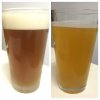I'm a Brew in a Bag guy.
I have worked on cloning a very simple SMaSH of one of my favorite IPAs. It's simply Pale 2-row and Galaxy.
Schlafly calls it their TIPA, or Tasmanian IPA.
My flavors and nose are spot on. Great. It's wonderful to drink ... But I want to create this beer as it's created by Schlafly.
Color is my issue.
BeerSmith puts it at about a 5.6 SRM, which I would agree the Schlafly product is. Mine are finishing, I would say, more in the 8-9 range. Much more copper in color. A 5.6 is practically a pilsner, maybe a bit darker.
The 2-Row I'm using is a 2 SRM, but this beer does get quite a bit of dry hop (I use pellets). Also, each batch I've done has fermented with some hops from the boil in the fermenter. Could that be darkening the color?
I cold crash, so I'm not taking any of the hops into by bottling bucket when I rack it, but I was wondering if dry hops and hops settled in the bottom could darken a beer this much?
My next one, I'm having no hops in the wort. Brewing an extra two gallons to avoid getting any mixed in. Going to settle it out while cooling after boil and avoiding as much as possible making it to fermenter.
Thanks for any input!
I have worked on cloning a very simple SMaSH of one of my favorite IPAs. It's simply Pale 2-row and Galaxy.
Schlafly calls it their TIPA, or Tasmanian IPA.
My flavors and nose are spot on. Great. It's wonderful to drink ... But I want to create this beer as it's created by Schlafly.
Color is my issue.
BeerSmith puts it at about a 5.6 SRM, which I would agree the Schlafly product is. Mine are finishing, I would say, more in the 8-9 range. Much more copper in color. A 5.6 is practically a pilsner, maybe a bit darker.
The 2-Row I'm using is a 2 SRM, but this beer does get quite a bit of dry hop (I use pellets). Also, each batch I've done has fermented with some hops from the boil in the fermenter. Could that be darkening the color?
I cold crash, so I'm not taking any of the hops into by bottling bucket when I rack it, but I was wondering if dry hops and hops settled in the bottom could darken a beer this much?
My next one, I'm having no hops in the wort. Brewing an extra two gallons to avoid getting any mixed in. Going to settle it out while cooling after boil and avoiding as much as possible making it to fermenter.
Thanks for any input!


